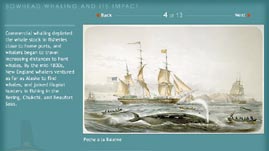Teachers' Domain - Digital Media for the Classroom and Professional Development
User: Preview

Source: New Bedford Whaling Museum
This interactive activity, adapted from material provided by the ECHO partners, presents images and text from the history of whaling in the North Atlantic Ocean and in the Bering, Chukchi, and Beaufort Seas in the Arctic. It looks at both Native Iñupiaq and commercial whaling, and introduces a landmark study conducted by John Bockstoce and Daniel Botkin. The study looked at changes in whale populations during the height of commercial whaling from 1849–1914.
Whale hunting dates back thousands of years. Although the whale's vital role as a natural resource may be less visible now, for much of human history whale products were essential to people in coastal areas around the world and of great importance in trade. Even today, many Native communities in Alaska and in other countries depend on the whale to support their way of life.
Whales are the largest animals on Earth, and were once abundant in many coastal areas of the Atlantic and Pacific Oceans. The earliest detailed records of European whaling come from the 13th century, when the typical approach to hunting was for ships to drive whales ashore. Other methods included shooting an arrow or harpoon into a whale. The harpoon was attached to a "drogue," an object that dragged after the whale, weighing it down until the whale tired and could be approached and killed. For some large whales, the entire whaling vessel, with crew on board, was used as a drogue. This scenario makes vivid the danger and risk associated with whaling. The drogues could be dragged hundreds of miles, only to capsize at the end of the journey with the loss of the entire crew.
Although this risk may seem extreme to us today, whale products — oil, meat, baleen, and skin — were so valuable that the hunt increased even as fisheries were depleted. In a pattern that was to be repeated over the centuries, the population of whales on Europe's North Atlantic coast became too small to support commercial whaling, so by the late 1600s, whalers moved to the North Atlantic regions near islands off Norway and Sweden. Within 60 years, there were few whales in these areas and hunters were pushed further into the Arctic regions.
By the first half of the 19th century, whaling in the North Atlantic had become so difficult and dangerous, and the number of whales so few, that the Atlantic commercial whaling trade essentially ended. Small numbers of hunters often brought back other sea mammals, but few whales.
The whaling trade moved once again, this time to the North Pacific. The business center of whaling remained based in the Atlantic region, specifically in New Bedford, Massachusetts, which had grown to be a very rich city during the previous trade. But the whaling cruises that set out on their two- to six-year journeys headed around South America for the North Pacific, and often beyond, to the Bering, Chukchi, and Beaufort Seas — a region known as the BCB — where they found bowhead whales.
The easy-to-hunt, economically valuable bowhead whales were plentiful, despite having been hunted for thousands of years by Native people in the region. Because the Native people depended on the whale for their survival, they accorded the creature a deep respect, taking no more than they needed for that year. Their fate was inextricably linked to the whales', and if the whale stock were to perish, so would their way of life.
The encounter between the commercial whaling interests and the Natives in the BCB regions, including the Iñupiat in Barrow, Alaska, was complex. Iñupiaq whalers and commercial whalers worked side by side in some cases, but there was also conflict and strife. Both communities learned from one another, sharing technologies.
Unfortunately, the stock of the bowhead in the BCB steadily decreased in the period from 1848 to 1914, and given the history of exhausting fisheries, this caused serious concern. Like other areas before it, the BCB went from being one of the most important suppliers of whale products to a depleted ocean zone where it was increasingly unsafe and unprofitable to hunt.
This factor, combined with the start of World War I, brought a decisive end to commercial whaling in this area, as well as to the small amount of whaling that was still taking place in far north regions of the Atlantic. Shipping routes were unsafe and world economic markets for whale products were disrupted. An additional contributing factor was the growing use of petroleum, which had become a practical substitute for the whale oil once widely used as fuel for lamps.
This did not mean that all whaling ceased in these regions. Native people continued to rely on the whale for survival and have continued to hunt bowhead into the 21st century.
One research project that has shed light on the effects of bowhead commercial whaling is a study by scientists John Bockstoce (American) and Daniel Botkin (Dutch). In their study, a sample of ships’ logs from the height of the BCB was examined, tabulated, and visualized. Through this work, Bockstoce and Botkin were able to form hypotheses (proposed explanations for their data) about the behavior of the bowhead, such as their travel through different regions of the BCB. Their work has also helped shape questions about acceptable limits for hunting on a subsistence basis in ways that will support the survival of both the bowhead and the Native people whose way of life depends on it.
 Loading Standards
Loading Standards Education through Cultural and Historical Organizations (ECHO) offers you resources on Teachers' Domain that strengthen knowledge of local culture and identity.
Education through Cultural and Historical Organizations (ECHO) offers you resources on Teachers' Domain that strengthen knowledge of local culture and identity.
